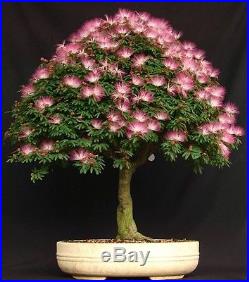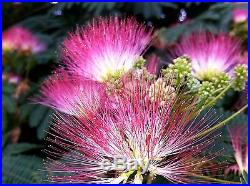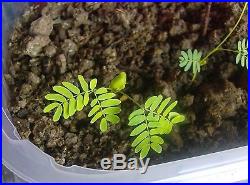



7 mimosa (albizia julibrissin) seeds, fresh exotic bonsai seeds, rare bonsai seeds. Incredibly easy to germinate – along with mimosa (albizia julibrissin) these are the easiest exotic bonsai plant seeds you will ever grow! Mimosa (albizia julibrissin): the tree of happiness. Albizia julibrissin (persian silk tree, pink silk tree) is a species of tree in the family fabaceae, native to southwestern and eastern asia. Albizia julibrissin is known by a wide variety of common names, such as persian silk tree or pink siris. It is also called lenkoran acacia or bastard tamarind, though it is not too closely related to either genus. The species is usually called “silk tree” or “mimosa”. Albizia julibrissin is a small deciduous tree growing up to 5 m tall, with a broad crown of level or arching branches. The bark is dark greenish grey in colour and striped vertically as it gets older. The flower colour varies from white to rich red-tipped flowers. The exquisite rosy colored pom-poms that mimosa trees, albizia julibrissin, produce are one of the reasons they are such a popular bonsai tree. Other ways these mimosa plants seem made for this art form include the delicate and fern like fronds covered in miniature leaves. These unique characteristics lend a particularly elegant and delicate feel to bonsai living sculptures. Mimosa trees also make great bonsai plants because they grow quickly. This means that the trunk and limbs of the plant thicken faster than other types of bonsai plants and sculpting them is thus easier. How to grow a mimosa (albizia julibrissin) tree from a seed. Prepare the mimosa seeds for sowing. Rub the end of each seed with a nail file until a small, pale spot appears on the hull. Soak them in hot water for 24 hours before sowing. Fill individual 5-inch biodegradable pots with a lightly moistened mixture of half sand and half loam. Sow one seed in each pot at a 1-inch depth. Spread a 1/4-inch-thick layer of sand over the soil. Set the pots outdoors against a south- or west-facing wall with full sun. Provide 75 f bottom heat with a propagation mat if the weather is cool and light shade at midday if daytime temperatures rise above 90 f. Carefully monitor the moisture level of the soil. Water to a 2-inch depth whenever the top 1/2 inch of soil dries out. Avoid overwatering or letting the soil dry out completely, since the mimosa seeds will fail. Watch for germination one to three weeks after sowing. Grow the seedlings under the same conditions as during germination until they reach 3 inches in height and produce several mature leaves. Transplant the mimosa trees into a permanent pots or in the garden. Cultivating a mimosa bonsai. The ideal environment to grow a mimosa bonsai requires a temperature of over 60 degrees at all times. Native to china, mimosa trees like a relatively dry climate and sunlight is a must. This makes them hard to grow in most climates but also means they are drought resistant. Rather than dryness, it is cold and wet weather that present the biggest problem to mimosa trees. Be careful of watering the mimosa bonsai as too much will drown the plant and too little will cause it to wilt. Damp roots are the leading cause of illness among bonsai plants. It is key to have an excellent drainage system for whatever the bonsai is planted in. When in bloom, avoid getting the flowers wet as this can make them fall off the plant sooner. On the flip side, a bonsai mimosa can become quite dry without suffering long-term side effects. Unlike some other plants used for bonsai, mimosa trees need full sunlight all day long so growing this plant inside is nearly impossible. Luckily, mimosa trees aren’t picky at all about what kind of soil they grow in. There are certainly soil ingredients that can be added to make the tree grow even better, but in general a mimosa will survive regardless of the sandiness, acidity or otherwise unappealing nature of the soil. Because of the notably large size of mimosa trees, these plants are sometimes not considered traditional bonsai. Their large size also makes them best suited for outdoor living if the climate allows. The seeds can be sent to any destination in the world.. We aim to provide our customers with the highest quality product and service. As with all seeds 100% germination success should not be expected although we select varieties known for their relatively higher success rates. Every effort is taken to ensure the quality of our seeds. However, it should be noted that seed germination is dependent on many factors including soil quality and conditions, temperatures and pests etc. Thank you for taking the time to review our listing.The item “7 Mimosa (Albizia Julibrissin) Seeds, Exotic Bonsai Seeds, Rare Bonsai Seeds” is in sale since Sunday, July 06, 2014. This item is in the category “Home & Garden\Yard, Garden & Outdoor Living\Flowers, Trees & Plants\Bonsai\Seeds”. The seller is “didycy” and is located in Paphos, Paphos. This item can be shipped worldwide.
- Brand: Bonsai
Tags: albizia, bonsai, exotic, julibrissin, mimosa, rare, seeds





















0